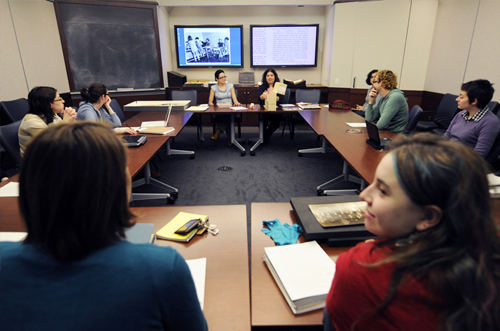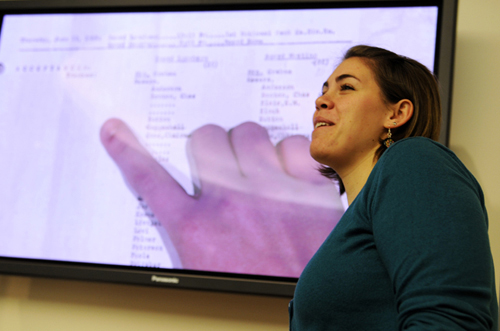| Sun | Mon | Tue | Wed | Thu | Fri | Sat |
|---|---|---|---|---|---|---|
| 1 | 2 | 3 | 4 | 5 | ||
| 6 | 7 | 8 | 9 | 10 | 11 | 12 |
| 13 | 14 | 15 | 16 | 17 | 18 | 19 |
| 20 | 21 | 22 | 23 | 24 | 25 | 26 |
| 27 | 28 | 29 | 30 | 31 |
CATEGORIES
RECENT ENTRIES
BLOG ROLL
Women's work

|
An 1895–96 course catalog was projected on the wall in the Rosenthal Special Collections Seminar Room Tuesday morning. One course in particular was highlighted: The Somatic and Psychic History of Woman was the first course on women at the University of Chicago, explained Monica Mercado, AM’06, and Katherine Turk, AM’07. The two history PhD students found the course catalog while researching women at the University for a course they taught fall quarter called Alma Mater: The History of Women at the University of Chicago, 1892–2008.
Like the teachers, the class’s 12 students, mostly women, are contributing their findings to a campus exhibit and shared their themes and items they’d found—to be final projects along with a seven- to nine-page paper—during Tuesday’s final class. Sarah Butler, ’09, examined mental-health services for female students from the 1940s to the 1970s. “The University seemed to think that mental health care was an optional thing to provide,” she said. Administrators were “patting themselves on the back” when they brought in humanist psychologist Carl Rogers to set up a counseling center, but students, Butler found through oral histories, “didn’t know about the services or didn’t think they were working.” The administration was particularly concerned about women’s psychological health, Butler said, because of the widespread belief that a woman’s “biological clock” and constant desire to be a mother “made it ten times harder to be mentally stable.”
 |
Lauren Guerrieri, ’10, looked at women’s training in World War I. Although they were not “tied down to husbands and children,” the University’s female students “brought skills associated with wives” to contribute to the war effort. Guerrieri had found a photograph of the Green Hall Knitting Group; an advertisement for Liberty Loans, one panel of which featured a soldier abroad and the other a patriotic woman at home; a page from Marion Talbot's “Patriotic Program for Women”; and a Maroon article about a group of women who sewed uniforms, complete with vests and hats, for the 180-member men’s ambulance corps. “It sounds like the war definitely changed what women were doing on campus,” Turk interjected. “What were those changes?” They were doing the same things as before, Guerrieri responded, but the war effort “gave them the ability to be involved in something national.”
 |
Other students researched famous female figures like African American anthropologist, activist, and dancer Katherine Dunham, PhB’36; the University’s first female trustee, Katharine Graham, AB’38; and child psychologist and pioneer of “popularity studies” Helen Koch, PhB’18, PhD’21. A few looked at radical women’s groups from the Sixties, such as the Chicago Women’s Liberation Union, which performed underground abortions and inspired the documentary Jane.
Turk and Mercado’s exhibit, “On Equal Terms: Experiences of Women at the University of Chicago,” opens in Special Collections March 16. The students’ parallel exhibit begins later in March at the Gender Studies Center. The group also plans to get together after finals to watch Jane. “I’m looking forward to coming to the archives in winter to read feminist news,” Butler joked during a lull, “when I don’t want to work on my BA.”
Shira Tevah, ’09
Photo by Dan Dry.
December 5, 2008
